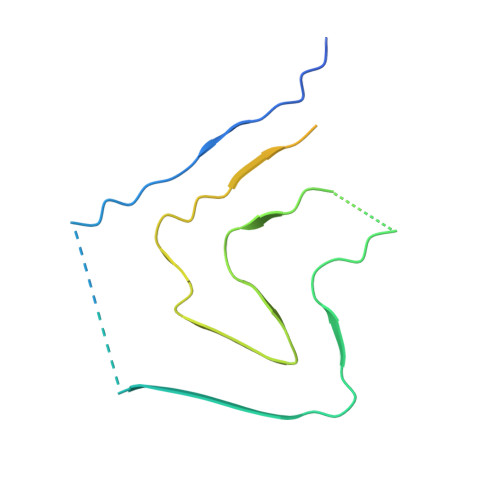Two new polymorphic structures of human full-length alpha-synuclein fibrils solved by cryo-electron microscopy.
Guerrero-Ferreira, R., Taylor, N.M., Arteni, A.A., Kumari, P., Mona, D., Ringler, P., Britschgi, M., Lauer, M.E., Makky, A., Verasdonck, J., Riek, R., Melki, R., Meier, B.H., Bockmann, A., Bousset, L., Stahlberg, H.(2019) Elife 8
- PubMed: 31815671
- DOI: https://doi.org/10.7554/eLife.48907
- Primary Citation of Related Structures:
6RT0, 6RTB, 6SST, 6SSX - PubMed Abstract:
Intracellular inclusions rich in alpha-synuclein are a hallmark of several neuropathological diseases including Parkinson's disease (PD). Previously, we reported the structure of alpha-synuclein fibrils (residues 1-121), composed of two protofibrils that are connected via a densely-packed interface formed by residues 50-57 (Guerrero-Ferreira, eLife 218;7:e36402). We here report two new polymorphic atomic structures of alpha-synuclein fibrils termed polymorphs 2a and 2b, at 3.0 Å and 3.4 Å resolution, respectively. These polymorphs show a radically different structure compared to previously reported polymorphs. The new structures have a 10 nm fibril diameter and are composed of two protofilaments which interact via intermolecular salt-bridges between amino acids K45, E57 (polymorph 2a) or E46 (polymorph 2b). The non-amyloid component (NAC) region of alpha-synuclein is fully buried by previously non-described interactions with the N-terminus. A hydrophobic cleft, the location of familial PD mutation sites, and the nature of the protofilament interface now invite to formulate hypotheses about fibril formation, growth and stability.
Organizational Affiliation:
Center for Cellular Imaging and NanoAnalytics (C-CINA), Biozentrum, University of Basel, Basel, Switzerland.














